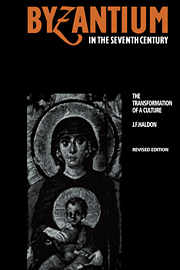Book contents
- Frontmatter
- Contents
- List of plates
- List of maps
- Preface and acknowledgements
- Preface to the revised edition
- List of abbreviations
- The sources
- Introduction
- 1 The background: state and society before Heraclius
- 2 The East Roman world c. 610–717: the politics of survival
- 3 Social relations and the economy: the cities and the land
- 4 Social relations and the economy: rural society
- 5 The state and its apparatus: fiscal administration
- 6 The state and its apparatus: military administration
- 7 Society, state and law
- 8 The imperial church and the politics of authority
- 9 Religion and belief
- 10 Forms of social and cultural organisation: infrastructures and hierarchies
- 11 Forms of representation: language, literature and the icon
- Conclusion: The transformation of a culture
- Addendum: Further observations on the question of the late ancient city
- Bibliography
- Index
10 - Forms of social and cultural organisation: infrastructures and hierarchies
Published online by Cambridge University Press: 13 November 2009
- Frontmatter
- Contents
- List of plates
- List of maps
- Preface and acknowledgements
- Preface to the revised edition
- List of abbreviations
- The sources
- Introduction
- 1 The background: state and society before Heraclius
- 2 The East Roman world c. 610–717: the politics of survival
- 3 Social relations and the economy: the cities and the land
- 4 Social relations and the economy: rural society
- 5 The state and its apparatus: fiscal administration
- 6 The state and its apparatus: military administration
- 7 Society, state and law
- 8 The imperial church and the politics of authority
- 9 Religion and belief
- 10 Forms of social and cultural organisation: infrastructures and hierarchies
- 11 Forms of representation: language, literature and the icon
- Conclusion: The transformation of a culture
- Addendum: Further observations on the question of the late ancient city
- Bibliography
- Index
Summary
As we have seen in the foregoing account, late Roman society was marked by a distinct introversion and introspectiveness from the late sixth century on. While this tendency is represented at the level of official, public consciousness – where it is most easily detected – as a form of ideological reorientation, as an attempt to reaffirm the traditions and values of the past, its roots lie in the material conditions of existence and the experiences and perceptions of people at all levels of society, from the lowliest tied peasant to the emperors themselves, and in the ways these people were able to give meaning to and come to terms with these experiences.
The interpretation placed upon these perceptions and experiences both promoted, and in its turn was promoted by, changes which also affected people's relationships to one another, and the concepts and vocabulary available to describe and explain these relationships. In terms of their response to the wider world, we have seen how some of these ideas were marked out. But they had effects upon what might be termed the social infrastructure, too, the relationships of individuals and groups through marriage and kinship, patronage and clientship and, most especially, in the context of seventh-century Byzantium, through and within the apparatuses and the hierarchy of the state.
INDIVIDUAL, FAMILY AND THE STATE
One of the most significant developments of the later Roman period was in the area of kinship structures, and the ways in which Christian marriage, as a formal system of gift-exchange, property-transmission and social alliances, came to play an increasingly central role in both the organisation of social relations and in the self-image of the society, as represented at least through the writings of Churchmen, hagiographers and jurists.
- Type
- Chapter
- Information
- Byzantium in the Seventh CenturyThe Transformation of a Culture, pp. 376 - 402Publisher: Cambridge University PressPrint publication year: 1990



